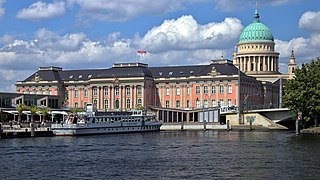
Potsdam is the capital and, with around 183,000 inhabitants, largest city of the German state of Brandenburg. It is part of the Berlin/Brandenburg Metropolitan Region. Potsdam sits on the River Havel, a tributary of the Elbe, downstream of Berlin, and lies embedded in a hilly morainic landscape dotted with many lakes, around 20 of which are located within Potsdam's city limits. It lies some 25 kilometres southwest of Berlin's city centre. The name of the city and of many of its boroughs are of Slavic origin.
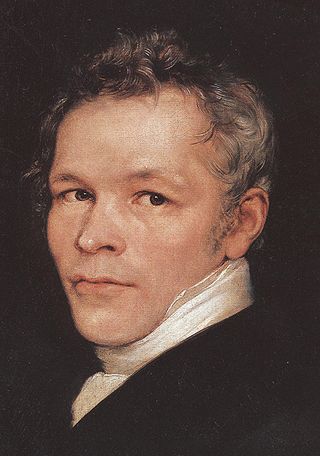
Karl Friedrich Schinkel was a Prussian architect, city planner and painter who also designed furniture and stage sets. Schinkel was one of the most prominent architects of Germany and designed both neoclassical and neogothic buildings. His most famous buildings are found in and around Berlin.

Bellevue Palace, located in Berlin's Tiergarten district, has been the official residence of the President of Germany since 1994. The schloss is situated on the banks of the Spree river, near the Berlin Victory Column, along the northern edge of the Großer Tiergarten park. Its name – the French for "beautiful view" – derives from its scenic prospect over the Spree's course.

Schloss Charlottenburg is a Baroque palace in Berlin, located in Charlottenburg, a district of the Charlottenburg-Wilmersdorf borough.

Schönhausen Palace is a Baroque palace at Niederschönhausen, in the borough of Pankow, Berlin, Germany. It is surrounded by gardens through which the Panke river runs. The palace is maintained by the Prussian Palaces and Gardens Foundation Berlin-Brandenburg and reopened to the public in 2009 after extensive restoration.
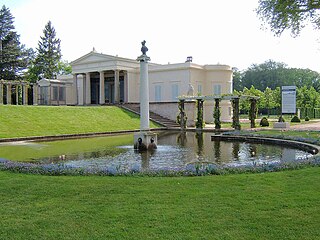
Charlottenhof Palace or Charlottenhof Manor is a former royal palace located southwest of Sanssouci Palace in Sanssouci Park at Potsdam, Germany. It is best known as the summer residence of Crown Prince Frederick William. Today it is maintained by the Prussian Palaces and Gardens Foundation Berlin-Brandenburg.

Peter Joseph Lenné was a Prussian gardener and landscape architect. As director general of the Royal Prussian palaces and parks in Potsdam and Berlin, his work shaped the development of 19th-century German garden design in the Neoclassical style. Laid out according to the principles of the English landscape garden, his parks are now World Heritage Sites.

The New Palace is a palace situated on the western side of the Sanssouci park in Potsdam, Germany. The building was begun in 1763, after the end of the Seven Years' War, under King Friedrich II and was completed in 1769. It is considered to be the last great Prussian Baroque palace.

Carl Gotthard Langhans was a Prussian master builder and royal architect. His churches, palaces, grand houses, interiors, city gates and theatres in Silesia, Berlin, Potsdam and elsewhere belong to the earliest examples of Neoclassical architecture in Germany. His best-known work is the Brandenburg Gate in Berlin, national symbol of today’s Germany and German reunification in 1989/90.
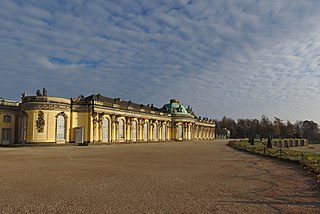
Sanssouci is a historical building in Potsdam, near Berlin. Built by Prussian King Frederick the Great as his summer palace, it is often counted among the German rivals of Versailles. While Sanssouci is in the more intimate Rococo style and is far smaller than its French Baroque counterpart, it, too, is notable for the numerous temples and follies in the surrounding park. The palace was designed and built by Georg Wenzeslaus von Knobelsdorff between 1745 and 1747 to meet Frederick's need for a private residence where he could escape the pomp and ceremony of the royal court. The palace's name is a French phrase that translates as "without concerns", meaning "without worries" or "carefree", emphasising that the palace was meant as a place of relaxation, rather than a seat of power.

Jelenia Góra Valley in Poland is a big valley at the Silesian northern side of the Western Sudetes and next to Kłodzko Valley the largest intermontane basin of the Sudetes. It is situated at an altitude of 250–400 meters above sea level and covers an area of 273 km2. In the 19th century, the lovely landscape attracted the Prussian high nobility, which built magnificent palaces, manors and parks. The enormous number of stately homes turned the valley into one of the most important garden landscapes in Middle Europe.

The Marmorpalais is a former royal residence in Potsdam, near Berlin in Germany, built on the grounds of the extensive Neuer Garten on the shores of the Heiliger See (lake). The palace was commissioned by King Friedrich Wilhelm II and designed in the early Neoclassical style by the architects Carl von Gontard and Carl Gotthard Langhans. The palace remained in use by the Hohenzollern family until the early 20th century. It served as a military museum under communist rule, but has since been restored and is once again open to the public.

The Schloss Britz is the former manor-house of the historical Rittergut and village Britz, now a district of Berlin-Neukölln. Today it is the headquarters of the cultural organization Kulturstiftung Schloss Britz and includes authentic reconstructed rooms from around 1880. The house is a museum demonstrating interiors of the Gründerzeit era. The manorial park is also well preserved with its mature trees and its 1890s system of trails. In 1997 the park was honored with the German Gustav Meyer Prize for the accuracy and historic authenticity of the reconstruction.

The Electoral Palace in Koblenz, was the residence of the last Archbishop and Elector of Trier, Clemens Wenceslaus of Saxony, who commissioned the building in the late 18th century. In the mid-19th century, the Prussian Crown Prince had his official residence there during his years as military governor of the Rhine Province and the Province of Westphalia. It now houses various offices of the federal government.

Moyland Castle is a moated castle in Bedburg-Hau in the district of Kleve, one of the most important neo-Gothic buildings in North Rhine-Westphalia. Its name derives from the Dutch word Mooiland which means "beautiful country". The name was probably coined by Dutch workers, whom the then-leaseholder Jacob van den Eger of the Lower Rhine brought to the property in 1307 to drain the surrounding wetlands.

Albrechtsberg Palace or Albrechtsberg Castle is a Neoclassical stately home above the Elbe river in the Loschwitz district of Dresden. It was erected in 1854 according to plans designed by the Prussian court and landscaping architect Adolf Lohse (1807–1867) at the behest of Prince Albert, younger brother of the Prussian king Frederick William IV.

Pillnitz Palace is a restored Baroque schloss at the eastern end of the city of Dresden in the German state of Saxony. It is located on the bank of the River Elbe in the former village of Pillnitz. It was the summer residence of many electors and kings of Saxony; it is also known for the Declaration of Pillnitz in 1791.

Park Glienicke, is an English landscape garden in the southwestern outskirts of Berlin, Germany. It is located in the locality of Wannsee in the Steglitz-Zehlendorf borough. Close to Glienicke Bridge the park is open to the general public. The park is part of the UNESCO World Heritage Site Palaces and Parks of Potsdam and Berlin. Within the ensemble it is one of the five main parks, the others being Sanssouci Park, New Garden, Babelsberg Park and Peacock Island (Pfaueninsel). Regarding diversity in gardening styles within the Potsdam park ensemble Park Glienicke is only superseded by Sanssouci Park. Furthermore, it is a park especially characterized by one personality due to the intense involvement of Prince Charles of Prussia. The park covers approximately 116 hectares
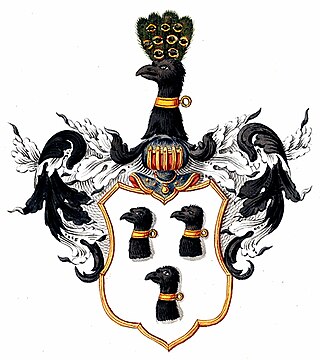
The von Treskow family is a prominent German aristocratic family, that descended as a branch of the medieval ("Uradel") House of Tresckow. The family rose to fame in Prussia due to their large landholdings and business ventures, resulting in many streets and boulevards being named after the family today.

The Treskow family burial ground is a historic landmark in Berlin, Germany. It was established in 1821 by Carl Sigismund von Treskow for his family, a branch of the von Treskow noble family, and is located in the park of Friedrichsfelde Palace in the Friedrichsfelde district.


























